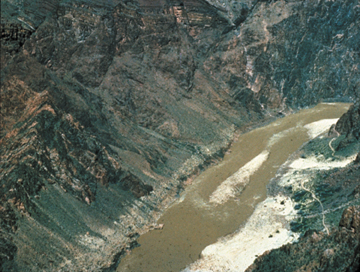 Rangers
in Grand Canyon National Park teach visitors that the Colorado River eroded
the 2-billion-year-old sedimentary rocks to form the canyon roughly 6 million
years ago. The park’s Web site describes the Grand Canyon as “an excellent
record of three of the four eras of geological time,” with a rich and diverse
fossil record, and a vast array of geologic features and rock types.”
Rangers
in Grand Canyon National Park teach visitors that the Colorado River eroded
the 2-billion-year-old sedimentary rocks to form the canyon roughly 6 million
years ago. The park’s Web site describes the Grand Canyon as “an excellent
record of three of the four eras of geological time,” with a rich and diverse
fossil record, and a vast array of geologic features and rock types.”The Colorado River cuts through sedimentary layers up to 2 billion years old in the Grand Canyon. A recent book, however, being sold in the Grand Canyon National Park, is sparking a national debate by taking a creationist view and saying the feature is only 6,000 years old. Image copyright U.S. Geological Survey.
But a book sold at the park’s bookstores since last fall says the canyon is merely 6,000 years old and was formed by Noah’s flood, as described in the Bible. Compiled by a Colorado River rafting guide, Grand Canyon: A Different View was placed on shelves alongside science books and other interpretive histories of the canyon. The book has provoked a new round in the national debate about biblical creationism and the separation of church and state.
The Grand Canyon Association, the nonprofit organization that operates the national park’s bookstores, chooses the books that are sold on the shelves, and the National Park Service (NPS) approves the list. The park’s Web site sells this book under the “natural history” section, alongside more scientific books; however, it describes the book as a “creationist view of how the Grand Canyon came to be.” Selling the book in the national park could be an “implied imprimatur from the NPS,” says Wilfred Elders, professor emeritus of geology at the University of California, Riverside. Elders helped reopen this debate by writing a scathing review of the book in the Sept. 23 Eos.
What the topic boils down to, Elders says, is whether or not religious views should be sold alongside science in a government bookstore. “I believe in freedom of expression and I am against censorship even for books such as this,” he says. But as “the aim of this book is to proselytize for a particular narrow religious viewpoint, it should not be for sale in a government-sanctioned bookstore.”
Echoing that concern in a letter to Joseph Alston, superintendent of Grand Canyon National Park, the president of the American Institute of Biological Sciences (AIBS) wrote: “Materials that present non-scientific explanations of our natural world should not be sold on federal property or used by federal agencies in a way that implies the material represents scientific explanations of the world.”
Robert Gropp, senior public policy representative of AIBS, says that their concern is “how science is presented in the park, and how science materials are being distributed so as not to confuse the public.” David Barna, chief of public affairs at NPS headquarters in Washington, D.C., says it is important to make a distinction between items in a bookstore versus educational materials in a park’s interpretive program. “Most public libraries in the United States have creationist books and Native American books on their shelves, but that doesn’t mean that the county school board is teaching those books in the schools and it doesn’t mean that the board of supervisors endorses these views,” he says.
NPS staff is required to teach the latest scientific methods in explaining the formation of geologic features, as do visitors center films and trailside exhibits. “We are not getting away from teaching science — that’s what we do. But while we’re out there giving these geology lectures, we must recognize that people have their own beliefs,” Barna says.
Despite varying reports suggesting that the book was originally shelved under the “science” section, Barna says that the book was always in the inspirational section of the bookstore.
Nevertheless, the selling of the creationist book has led to an NPS review about how they pick the books that they sell. “We’re trying to get the policy, interpretation and legal people together to develop a policy statement,” Barna says. “And it needs to be a policy statement that works at several other parks as well because other geologic parks across the West might have similar issues come up.”
Although he says that the review process will take some time, he anticipates a decision soon about the issue of religion and science in NPS bookstores. “We’re trying to find some compromise that’ll satisfy both sides,” Barna says.
Elders endorses the establishment of guidelines to prevent the promotion of “pseudo-science” in national parks. “The Holocaust Museum in Washington, D.C., does not sell books that deny that the Holocaust ever occurred because such books are pseudo-history. This book is an extreme example of pseudo-science,” he says.
Geoscientists say they would like to see the national park leading the way toward educating visitors about the canyon’s rich geologic history. In a letter to Alston, the presidents of seven geoscience societies, including the American Geological Institute (which publishes Geotimes), voiced their concerns: “The Grand Canyon provides a remarkable and unique opportunity to educate the public about earth science. In fairness to the millions of park visitors, we must clearly distinguish religious tenets from scientific knowledge.”

